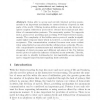Free Online Productivity Tools
i2Speak
i2Symbol
i2OCR
iTex2Img
iWeb2Print
iWeb2Shot
i2Type
iPdf2Split
iPdf2Merge
i2Bopomofo
i2Arabic
i2Style
i2Image
i2PDF
iLatex2Rtf
Sci2ools
ACNS
2009
Springer
2009
Springer
Performance Measurements of Tor Hidden Services in Low-Bandwidth Access Networks
Abstract. Being able to access and provide Internet services anonymously is an important mechanism to ensure freedom of speech in vast parts of the world. Offering location-hidden services on the Internet requires complex redirection protocols to obscure the locations and identities of communication partners. The anonymity system Tor supports such a protocol for providing and accessing TCP-based services anonymously. The complexity of the hidden service protocol results in significantly higher response times which is, however, a crucial barrier to user acceptance. This communication overhead becomes even more evident when using limited access networks like cellular phone networks. We provide comprehensive measurements and statistical analysis of the bootstrapping of client processes and different sub-steps of the Tor hidden service protocol under the influence of limited access networks. Thereby, we are able to identify bottlenecks for low-bandwidth access networks and to suggest i...
| Added | 25 May 2010 |
| Updated | 25 May 2010 |
| Type | Conference |
| Year | 2009 |
| Where | ACNS |
| Authors | Jörg Lenhard, Karsten Loesing, Guido Wirtz |
Comments (0)

